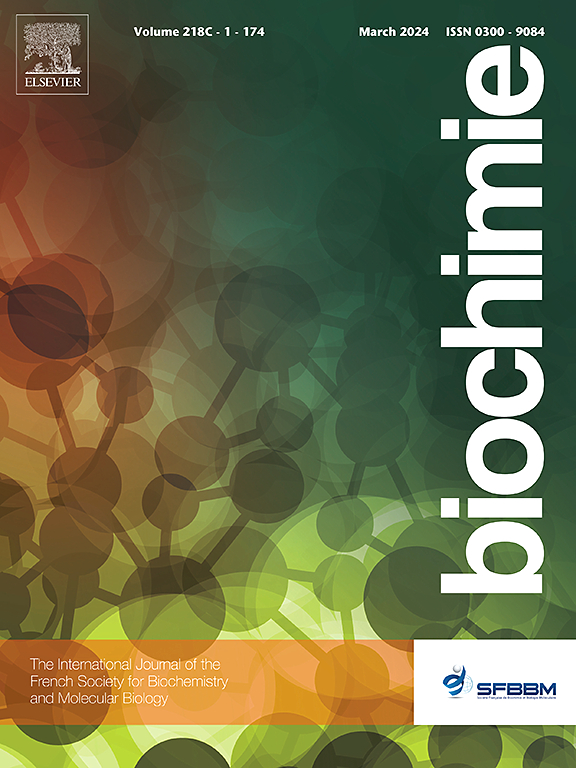小热休克蛋白与bag3的相互作用。
IF 3
3区 生物学
Q2 BIOCHEMISTRY & MOLECULAR BIOLOGY
引用次数: 0
摘要
BAG3是一种通用的适配蛋白,参与多种细胞过程,包括调节细胞凋亡、伴侣辅助的选择性自噬和热休克蛋白功能。采用粒径排除色谱、天然凝胶电泳和化学交联等方法分析了小热休克蛋白(sHsps)及其α-结晶蛋白结构域(Acds)与全长BAG3蛋白及其IPV结构域的相互作用。HspB7与HspB1三维突变体(模拟磷酸化)无相互作用,HspB6与全长BAG3弱相互作用,HspB8与全长BAG3强相互作用。与全长sHsps相比,它们的α-结晶蛋白结构域(AcdB1、AcdB5和AcdB6)能够与BAG3相互作用,其中AcdB8仍然是最强的相互作用体。在分析的所有全长sHsps中,只有HspB8与BAG3的IPV结构域结合。AcdB1、AcdB5、AcdB6和AcdB8与BAG3的IPV结构域相互作用,其中AcdB8的结合效率最高。HspB8(或其Acd)与BAG3的IPV结构域形成的交联配合物的化学计量比为2:1,而其他sHsps及其Acds形成的交联配合物的化学计量比为1:1。这些发现表明,虽然BAG3的IPV结构域和sHsps的Acds在结合中发挥重要作用,但其他结构区域也对这种相互作用起着重要作用。BAG3与HspB8之间独特的结合效率可能归因于HspB8固有的无序性和简单的寡聚结构。本文章由计算机程序翻译,如有差异,请以英文原文为准。

Interaction of small heat shock proteins with BAG3
BAG3 is a universal adapter protein involved in various cellular processes, including the regulation of apoptosis, chaperone-assisted selective autophagy, and heat shock protein function. The interaction between small heat shock proteins (sHsps) and their α-crystallin domains (Acds) with full-length BAG3 protein and its IPV domain was analyzed using size-exclusion chromatography, native gel electrophoresis, and chemical cross-linking. HspB7 and the 3D mutant of HspB1 (which mimics phosphorylation) showed no interaction, HspB6 weakly interacted, and HspB8 strongly interacted with full-length BAG3. In contrast to the full-length sHsps, their α-crystallin domains (AcdB1, AcdB5, and AcdB6) were able to interact with BAG3, with AcdB8 again being the strongest interactor. Among all the full-length sHsps analyzed, only HspB8 bound to the IPV domain of BAG3. AcdB1, AcdB5, AcdB6, and AcdB8 interacted with the IPV domain of BAG3, with AcdB8 displaying the highest binding efficiency. The stoichiometry of crosslinked complexes formed by HspB8 (or its Acd) and the IPV domain of BAG3 was 2:1, whereas for the other sHsps and their Acds, it was 1:1. These findings suggest that while the IPV domain of BAG3 and the Acds of sHsps play an important role in binding, other structural regions significantly contribute to this interaction. The unique binding efficiency between BAG3 and HspB8 may be attributed to the intrinsic disorder and simple oligomeric structure of HspB8.
求助全文
通过发布文献求助,成功后即可免费获取论文全文。
去求助
来源期刊

Biochimie
生物-生化与分子生物学
CiteScore
7.20
自引率
2.60%
发文量
219
审稿时长
40 days
期刊介绍:
Biochimie publishes original research articles, short communications, review articles, graphical reviews, mini-reviews, and hypotheses in the broad areas of biology, including biochemistry, enzymology, molecular and cell biology, metabolic regulation, genetics, immunology, microbiology, structural biology, genomics, proteomics, and molecular mechanisms of disease. Biochimie publishes exclusively in English.
Articles are subject to peer review, and must satisfy the requirements of originality, high scientific integrity and general interest to a broad range of readers. Submissions that are judged to be of sound scientific and technical quality but do not fully satisfy the requirements for publication in Biochimie may benefit from a transfer service to a more suitable journal within the same subject area.
 求助内容:
求助内容: 应助结果提醒方式:
应助结果提醒方式:


